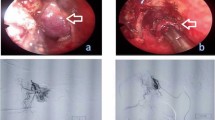Abstract
Sinonasal glomangiopericytoma (GPC) is an uncommon primary sinonasal neoplasm showing a perivascular myoid differentiation. Originally perceived as an intranasal counterpart to soft tissue hemangiopericytomas, initial immunohistochemical reports showed mostly negative to focal weak reactivity for CD34 as useful in separating GPC (almost always benign) from morphologic mimics, mainly solitary fibrous tumor (potentially aggressive). In anecdotally encountering cases of GPC with CD34 reactivity beyond the expected weak/negative immunoprofile, we sought to formally evaluate CD34 staining in 10 cases of GPC from two different vendors in conjunction with a meta-analysis of other GPC series reporting CD34 staining. Ten cases of GPC were retrieved from the authors’ pathology archives (left nasal cavity = 7, right nasal cavity = 3; 5 men, 5 women; average age 59.0 years with range of 43–77 years). Follow-up showed no evidence of disease after complete resection from all 10 cases (average follow-up length of 53.3 months, range 6–106 months). All 10 GPC cases (100%) showed positivity using CD34 from Leica (QBend10 clone), with most showing moderate to diffuse staining intensity and moderate extent, while only 2 of 10 cases (20%) showed positivity using CD34 from Ventana (QBend10 clone), with both positive cases showing weak staining intensity and focal extent. Literature review of other studies (reporting ≥ 5 GPC cases) found a wide spectrum of CD34 positivity ranging from 0 to 100%; including our GPC cases, CD34 showed a cumulative positivity of 28%. Although negative CD34 reactivity has been historically regarded as prototypic for GPC, in this study we have exposed laboratory variability in CD34 expression and have shown that reliance on expected negative reactivity in GPC can be a clinically relevant diagnostic pitfall. Our findings suggest a panel approach in selecting diagnostic immunostains rather than relying on CD34 alone in the assessment of spindle cell neoplasms in the sinonasal tract with admixed prominent staghorn-like vasculature.


Similar content being viewed by others
References
Compagno J, Hyams VJ. Hemangiopericytoma-like intranasal tumors A clinicopathologic study of 23 cases. Am J Clin Pathol. 1976;66(4):672–83.
Stout AP, Murray MR. Hemangiopericytoma: a vascular tumor featuring zimmermann’s pericytes. Ann Surg. 1942;116(1):26–33.
Thompson LD, Miettinen M, Wenig BM. Sinonasal-type hemangiopericytoma: a clinicopathologic and immunophenotypic analysis of 104 cases showing perivascular myoid differentiation. Am J Surg Pathol. 2003;27(6):737–49.
Tse LL, Chan JK. Sinonasal haemangiopericytoma-like tumour: a sinonasal glomus tumour or a haemangiopericytoma? Histopathology. 2002;40(6):510–7.
Kuo FY, Lin HC, Eng HL, Huang CC. Sinonasal hemangiopericytoma-like tumor with true pericytic myoid differentiation: a clinicopathologic and immunohistochemical study of five cases. Head Neck. 2005;27(2):124–9.
Agaimy A, Barthelmeß S, Geddert H, et al. Phenotypical and molecular distinctness of sinonasal haemangiopericytoma compared to solitary fibrous tumour of the sinonasal tract. Histopathology. 2014;65(5):667–73.
Lasota J, Felisiak-Golabek A, Aly FZ, Wang ZF, Thompson LD, Miettinen M. Nuclear expression and gain-of-function β-catenin mutation in glomangiopericytoma (sinonasal-type hemangiopericytoma): insight into pathogenesis and a diagnostic marker. Mod Pathol. 2015;28(5):715–20.
Jo VY, Fletcher CDM. Nuclear β-catenin expression is frequent in sinonasal hemangiopericytoma and its mimics. Head Neck Pathol. 2017;11(2):119–23.
Doyle LA, Vivero M, Fletcher CD, Mertens F, Hornick JL. Nuclear expression of STAT6 distinguishes solitary fibrous tumor from histologic mimics. Mod Pathol. 2014;27(3):390–5.
Yoshida A, Tsuta K, Ohno M, et al. STAT6 immunohistochemistry is helpful in the diagnosis of solitary fibrous tumors. Am J Surg Pathol. 2014;38(4):552–9.
Thompson L, Flucke U, Wenig M. Sinonasal Glomangiopericytoma. In: El-Naggar A, Chan J, Grandis J, et al., editors. WHO classification of head and neck tumors. 4th ed. Lyon: IARC Press; 2017. p. 44–5.
Park ES, Kim J, Jun SY. Characteristics and prognosis of glomangiopericytomas: a systematic review. Head Neck. 2017;39(9):1897–909.
Funding
This study was funded, in part, by the Jane B. and Edwin P. Jenevein M.D. Endowment in Pathology at UT Southwestern Medical Center.
Author information
Authors and Affiliations
Corresponding author
Additional information
Publisher's Note
Springer Nature remains neutral with regard to jurisdictional claims in published maps and institutional affiliations.
Rights and permissions
About this article
Cite this article
Sangoi, A.R., Bishop, J.A. Variability of CD34 Expression in Sinonasal Glomangiopericytoma: A Potential Diagnostic Pitfall. Head and Neck Pathol 14, 459–464 (2020). https://doi.org/10.1007/s12105-019-01063-9
Received:
Accepted:
Published:
Issue Date:
DOI: https://doi.org/10.1007/s12105-019-01063-9




